Minu esimene kokkupuude delfiinidega oli raamat “Delfiinia”. Lugesin ja kopeerisin selle ribadeks. Paraku olin siis liiga väike, et tõelisi delfiine osata igatseda. Või kui igatsesingi, siis ei mäleta sellest midagi.
Järgmine kokkupuude oli kaudne, pigem energeetiline ja läbi Crystali. Kui ta saabus oma esimeselt Havai reisilt ja delfiinidest rääkis. Ta vaimustus ajas mind naerma ja vastasin selle umbes niiet mis seal nüüd ikka joovastuda, ujusid suurte räimedega ja nemad siis skänneerisid sind… daaaaa…
Kui ma aga kord Havail ise vetruvatel jalgadel ookeanist väljusin, olles just ujunud 2 tundi metsikute delfiinidega, hoidis Crystal mu vibravat keha püsti ja ainult naeris. Esimene lause, mis ma talle ütlesin, oli – Ma ei ütle enam mitte iialgi delfiini kohta kala. Edasised ujumised olid muinasjutulised. Ma jumaldan neid ookeani ingleid, kes muutsid mu elu. Olen neid ujumisi kirjeldanud oma blogis.
Ühel päeval leidsin Facebookis põneva inimese, Nicole McLachlani (http://www.facebook.com/pathtoprotect?fref=ts) kellel oli ilusaid delfiinipilte, aga ilusate piltide seas oli ka väga jubedaid. Need kujutasid delfiinikütteja tapmisi. Olin päevi sellest shokis. Mingil hetkel olin jälle tema blogis, hoidsin pead käte vahel ja ägasin:”Kuidas mina aidata saan? Te olete mulle nii palju head teinud, mida mina teie heaks teha saan..!?” Järgmisel hetkel oli mu ümber parv delfiine ja üks neist “rääkis”: “Saad aidata küll. Oleks vaja sukelduda võrkudeni ja võrgud ookeanis lihtsalt lahustada. Aita palun!”
Ma tegin seda ja see õnnestus. Koeraga rannas jalutades kuulsin järgmisel päeval tihti delfiinide hääli ja oli veider tahtmine kapuuts peast lükata, sest hingamine toimus nagu pealae kaudu. See oli koomiline ja sürr, aga see oli minu hetkereaalsus, tuli leppida olukorraga. :))
Paar päeva hiljem pani Nicole üles uued pildid. Üks hullem kui teine ja mõni eriti julm-
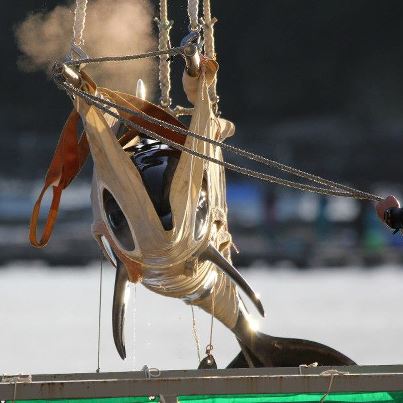
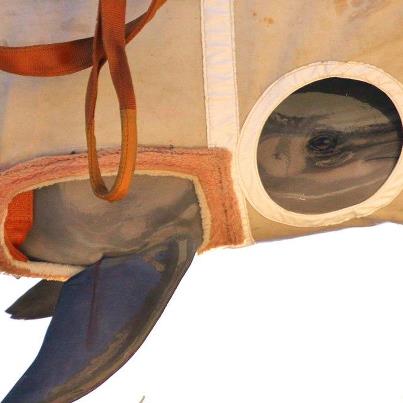
Panin pildi oma lehele ja kirjutasin alla:
“Sõbrake, sorry, ma saan su heaks teha vaid seda, et sukeldun vaimus su juurde ja rebin kõik need krdi kilide võrgud läbi. Ma olen seda teinud, aga see ununeb ikka ja jälle, sest ma olen vaid inimene – ma arvan oma peaga, et minul on jamasid…aga neid pilte vaadates kuulan ma oma südant ja sukeldun sinu juurde, sest hoopis sinul on tõelised jamad. Kes veel ühineb? Ärge kirjutage siia, et jee, ühinen…kui te tegelikult ei tee seda. Iga inimene, kes on korragi elus ujunud metsiku ja vaba delfiiniga, teab, mis tunne on praegu seda pilti vaadata. See on tohutu jõud ja jõuetus korraga. Jõud viha kui tohutult tugeva emotsiooni näol ja jõuetus neid abipaluvaid hirmunud silmi vaadates. Aga ma saan oma viha transformeerida ümber selleks jõuks, mis aitab delfiine püüdvaid võrke lahustada…ja mu jõuetus kaob. Sest ma olen midagi teinud. Midagigi…
Ja minu vaimusilmas ujuvad KÕIK selle planeedi delfiinid ja vaalad vabaduses.”
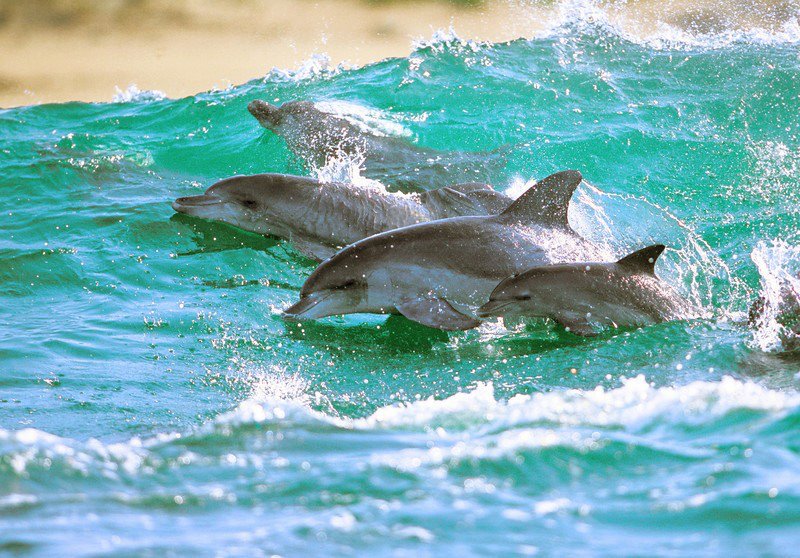
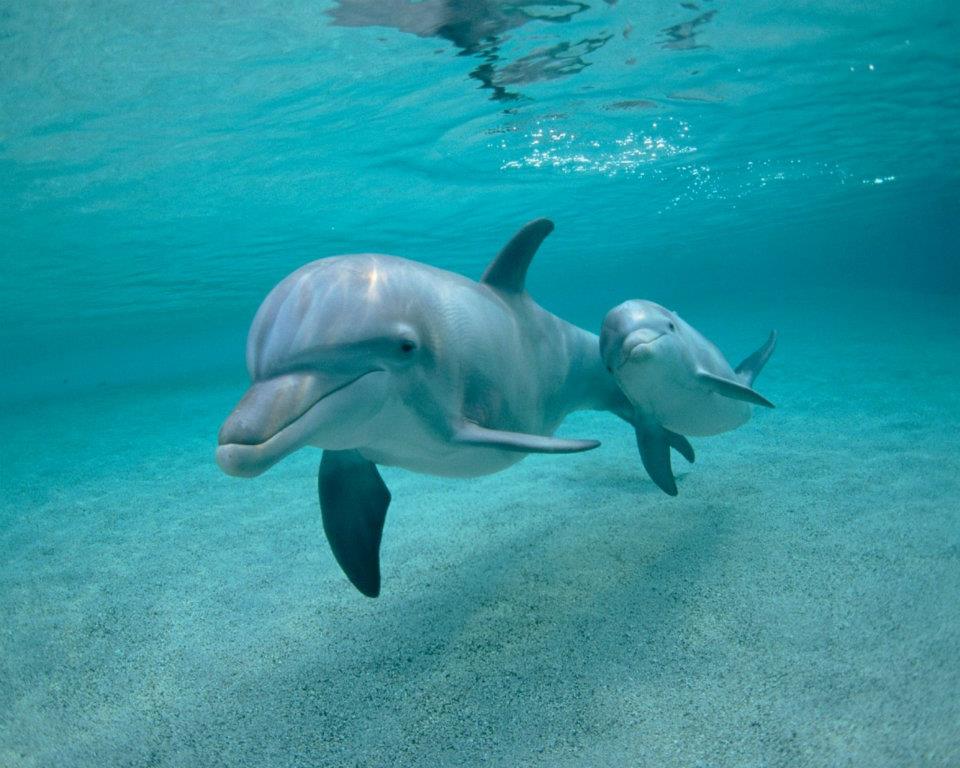

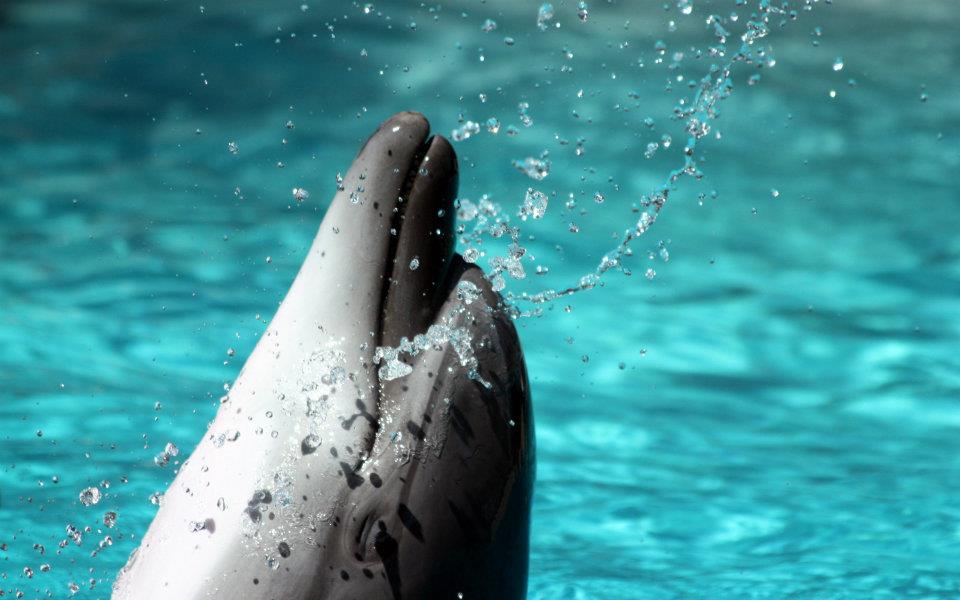
Pildid netist.
Lihtsalt tekib küsimus – kuidas see võimalik on, et sellest tehakse pilte, seda filmitakse, see levib üle maailma ja …see jätkub IKKAGI? Mis planeedil ma elan??? On see ikka Maa? Ja mida Maa ise sellistel hetkedel kogeb?
Eile, 4jaanuaril, oli meil väikese grupiga Fb-st sukeldumine ja me tegime seda, mida vaja. See ei ole raske ja sellega saab hakkama igaüks, lihtsalt väike teejuhis ette siin. Aga sel teel ei olegi otseseid juhiseid, mida ja kuidas järgida. Ainus kompass on süda.
Silmad kinni, astu ookeani. Vesi on soe. Astume paar sammu ja libistame end ookeani. Me oleme kõik koos, me oleme oma parves, ükskõik palju meid täna koos on. Mul on tunne et meie ümber tuleb täna teatud grupp delfiine, ja me hargneme. Need delfiinid teavad juba, miks me seal oleme. Niiet me lihtsalt järgneme neile. Aga võib paluda delfiinidel või delfiinil, kes sinuga suhtlema tuleb, et ta juhataks või saadaks meid võrkudeni. Võrku võib puudutada või lükata lahti nagu kardina…kuidas kujuneb. Siin ei ole tehnikat, selle retke dikteerib süda. Kohtume kl 21…
Üks delfiinidest palub kohe edasi öelda ühele inimesele, kes tänases grupis kardab ujumist – õige delfiin ujub su juurde ja võta ta seljauimest lihtsalt kinni. Te libisete koos sinna kuhu vaja. Litsalt mängige… nii nagu delfiinid, ja kõik õnnestub. Kui läheb pusimiseks või tunned õhupuudust, siis keera end selili vette ja lihtsalt leba- kõik on hästi… Ja vbl polegi teie pildis võrke, öelge siis delfiinidele edasi, et hoidku võrkudest eemale…
Taustaks võid kõrvaklappidesse panna järgmise muusika- http://www.youtube.com/watch?
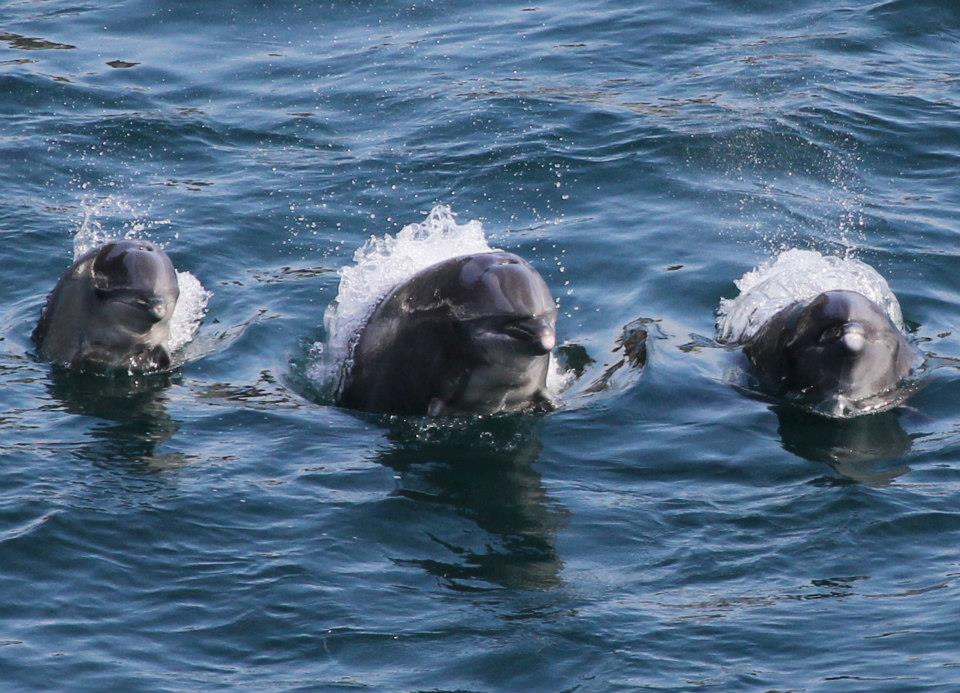
***
Täna hommikul, 5 jaanuari,l oli Nicole üles pannud uued pildid ja loo, mille siia copin.
(http://www.dailymail.co.uk/news/article-2257426/The-dolphin-snatchers-Mail-investigation-exposes-vile-trade-animals-sold-100-000-aquariums-suffer-unimaginable-cruelty.html)
The dolphin snatchers: Mail investigation exposes vile trade where animals are sold for up to £100,000 each to aquariums where they suffer unimaginable cruelty
By STEVE BIRD
For the men wearing wetsuits wading in a shallow bay teeming with trapped wild dolphins, the decision is as simple as it is ruthless. Running their hands carefully over each dolphin’s body, they check to ensure the creature is free from scars, particularly on the dorsal and tail fins.
At first glance this human interaction with one of the few creatures said to possess an intellect close to our own appears an act of caring tenderness. But in reality, these are businessmen selecting their merchandise for a multi-million-pound trade in live dolphins. The best specimens (usually young females, or cows) are removed from their families to be sold live for between £50,000 and £100,000 each to aquariums. The dolphins they reject — the ones with minor blemishes on their skin — are slaughtered where they are trapped in that cove at Taiji on the south coast of Japan.
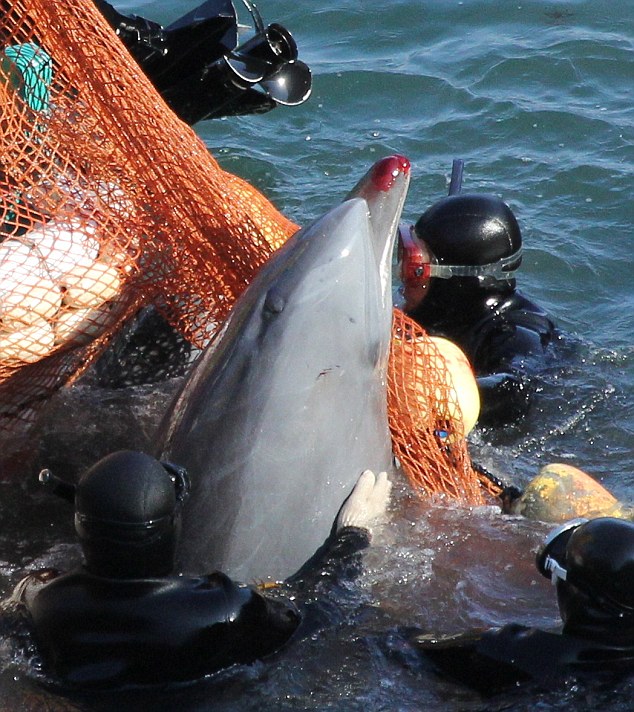
In a frenzy of violence that has shocked animal lovers and marine environmentalists around the world, some are speared repeatedly by fisherman circling in motorboats whose propellers often slice the dolphins’ skin. Others are simply held underwater to drown. Sometimes, metal pole is rammed into their blubber in the hope of shattering the mammal’s spine. A cork stopper is then hammered into the hole where the rod was forced in, to try to reduce the blood spilt into the sea — to conceal the extent of the slaughter. Invariably a few dolphins try to make a break for freedom and attempt to jump over the netting that seals off the bay.However, amid the blood-red waters almost all of them eventually succumb to their fate. These barbaric scenes took place just before Christmas, during a hunting season when Japanese fishermen ‘harvest’ dolphins to supply to aquariums for human entertainment.It is estimated that for every wild dolphin caught to be trained to perform tricks in captivity, around four times that number are slaughtered. The fishermen then sell off the meat for about £10 a kilo. They see the creatures as a menace because they pose a threat to the dwindling reserves of fish in the Pacific Ocean. But for those that survive the slaughter, life might as well be over.The stress a dolphin suffers as a result of being captured, transported and imprisoned in a small tank dramatically reduces its lifespan.
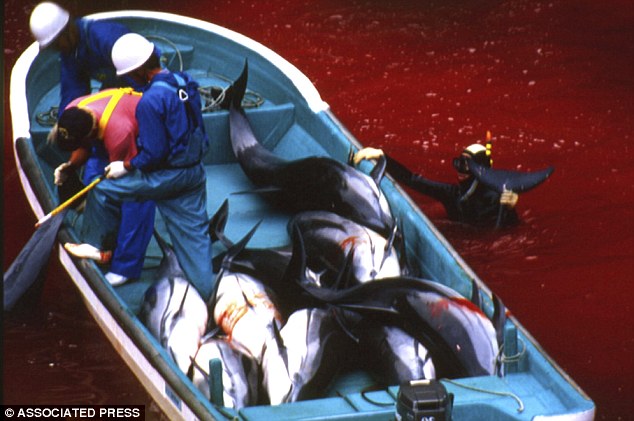
While wild dolphins live for up to 60 or 70 years, captured ones often perish when they are as young as eight, say environmentalists. According to marine experts, some dolphins are so distressed by their capture that they commit suicide. One of the most vocal campaigners against the practice is also one of the most knowledgeable — he is the very man who helped create and promote the worldwide aquarium industry. Ric O’Barry became famous in the Sixties as the on-screen trainer of the five dolphins that played Flipper in the popular U.S. TV series, which was also hugely successful in Britain. For ten years he worked at Miami Seaquarium, where he trained the wild mammals after capturing them on hunting expeditions in the Pacific. But when Kathy, the main dolphin that played Flipper, died in his arms after apparently losing the will to live, he says it dawned on him how cruel captivity is for such intelligent and social creatures.
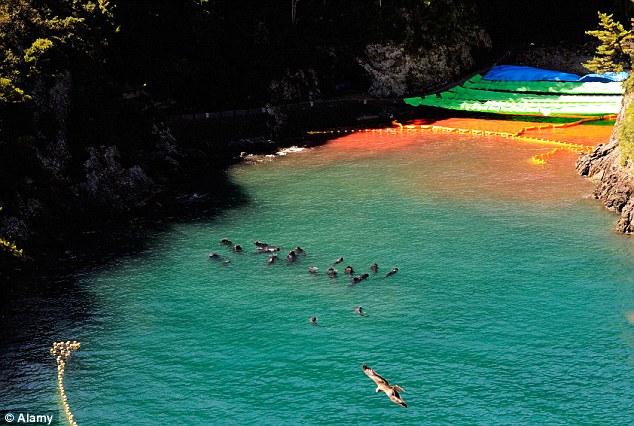
For the past 40 years he has travelled the world highlighting the plight of dolphins in amusement parks, and even releasing them from those parks into the wild, often getting arrested in the process. Three years ago, he made a documentary called The Cove, which revealed the truth about the ‘drive hunts’ that take place at Taiji in Japan. Yet since then, the practice has continued unabated — as these photographs demonstrate only too graphically. O’Barry, 73, says live dolphins taken from the waters in Japan are shipped to aquariums and ‘swim-with-dolphin’ centres mostly in the Far East. Speaking from his home in Miami, O’Barry says: ‘Taiji is the number one location to get dolphins for the dolphinarium industry — or what I called “abusement parks”.’ Although there are no international laws banning the shipment of live dolphins to those countries prepared to accept them, O’Barry claims the dolphins undergo terrible suffering.
‘After enduring a painfully long period of transportation, they are put into often filthy and confined conditions at aquariums ‘These are free-ranging creatures with a large brain whose primary sense is sound. Some have been placed in aquariums at casinos where the noise is appalling. These environments are hellholes to creatures used to the open seas and which often swim up to 100 miles in a day in search of food. ‘They are taken away from the two most important aspects of their life — the world of oceanic sound and their families. ‘They end up suffering depression. I believe they are also capable of trying to commit suicide.’ Two years ago at the Okinawa Churaumi Aquarium in south-western Japan, hundreds of tourists at a marine show looked on in astonishment as a large dolphin rose up out of the water tank to balance precariously on the glass barrier of the aquarium. It then threw itself out of the water on to the ground.
Touchingly, the other dolphins in the tank swam to the glass wall to look at the plight of their companion, called Kuru (meaning ‘black’). The dolphin was eventually put into a huge tarpaulin sling and winched by a crane back into the water. The incident was filmed by an appalled American tourist, who passed the footage on to O’Barry. While many thought the mammal was trying to make a break for freedom, O’Barry believes it was more likely it wanted to commit suicide. ‘It was depressed and wanted to end it,’ O’Barry says, adding that it had been in captivity for six years after being taken from the wild. ‘I have seen it many, many times. They are living in a world of sensory deprivation, then bombarded with a wall of noise from the crowd.’ After the clip was made public the aquarium managers immediately issued a statement saying the dolphin was ‘playing around’ and suffered minor scratches and bruises on its head and fin. It was, they insisted, fine and enjoyed a healthy serving of mackerel and squid once returned to the tank. They did admit, however, that dolphins occasionally jump out of the water on to dry land, so they have now placed crash mats around the perimeter of the three tanks in their amusement park to avoid serious injury. The trade in wild dolphins to U.S. aquariums has ceased due to public outrage, and the high-profile campaigns of activists like O’Barry. There are no captive dolphins in Britain either as a result of a public backlash against the shows. Only a few are on show in Europe, and these animals were born in captivity — although O’Barry fears even this poses a threat to the mammals’ welfare because there is now a problem with inbreeding. O’Barry exhorts the public never to attend dolphin aquariums. ‘The solution lies with the consumer,’ he says. ‘Don’t buy a ticket for a captive dolphin show. This is a multi-million-dollar industry I helped create. I remember loading them onto the planes after the Flipper show became so popular. At one point there were more dolphins in the UK than in Florida. ‘But the consumer now has to bring his power to bear on this trade, which also results in the slaughter of all those other dolphins. There is more money in live dolphins than dead ones, but the one fuels the other.’
In Taiji, Nicole McLachlan, of the Sea Shepherd Conservation Society, is part of a team monitoring the capture and killing of dolphins that takes place from September to March each year in the small port where whales have been hunted since the 17th century. Last month alone, she claims up to 170 cetaceans were killed, including pilot whales, risso, striped and bottlenose dolphins. More than 100 were captured for aquariums. Such is worldwide concern over the slaughter that the fishermen try to hide it. ‘Nowadays the kills take place out of sight underneath blue and brown tarpaulins that cover the bay,’ the Australian marine environmentalist says. The carnage lasts about half an hour. It is harrowing. They are terrified. You hear the dolphins screaming; it’s a high-pitched wailing sound. There is splashing as they thrash around in the water. Young dolphin calves are often among those slaughtered within the cove; some are younger than a year old.’ Yet locals are adamant it should continue. Police monitor the activists while many of the town’s 3,500 residents — most of whom are linked to the fishing industry — arrive to support the fishermen in this Japanese tradition. The ‘drive hunt’ (‘oikomiryou’ in Japanese) involves five or six large fishing vessels sailing out to sea to find a pod of dolphins.
***
Otsisin ja leidsin Youtubest ka kurikuulsa filmi, nimega Laht. “The Cove”
http://www.youtube.com/watch?v=_eknshN_uhM
Vaatasin, nutsin ja mõtlesin – kuidas see võimalik on? Film on aastast 2009 ja see jama jätkub ikka veel???
***
Aga eilseõhtusest sukeldumisest sõprade juurde, sain ka täna paar mõnusat peegeldust:
„Eile jäi silma sinu kommentaar: Üks delfiinidest palub kohe edasi öelda ühele inimesele, kes tänases grupis kardab ujumist – õige delfiin ujub su juurde ja võta ta seljauimest lihtsalt kinni…
Ilma, et ma enne oleks midagi su plaanist minna võrke lõhkuma teadnud oleks. Kui seda kommentaari lugesin siis tundsin kohe ära, et see viimane sõnum oli mulle mõeldud… kummaline… Ühinesin teiega 21.00, nii kui vee äärde jõudsin oli üks delfiin mind juba ootamas ja tõesti ma liuglesingi läbi vee hoides seljauimest kinni. Kogu selle aja ma rääkisin valguskeeles ja mingist ajast vist tegin suht sarnaseid häälitsusi delfiinidega ja siis märkasin et lihtsalt lebangi selili vees. Põnev kogemus oli. “
“Saime siis rannas kokku nagu kirjutasid…vette…siis esialgu oli üks delfiin minuga, tema näitas,mina purustasin…maru kergelt purunesid need võrgud… tükeldasime neid ikka päris mitmes kohas… hiljem lisandus veel 3 tk,kokku siis 4.. ja ma nutsin, silmad olid vees… Lõpuks saatsid delfiinid veel mind kaldani…seal nägin siis ka teid…tegime grupikalli….ommisime mitu korda ja saatsime selle Universumisse. see oli minu jaoks väga eriline kogemus…hakkan seda ise ka tihemini tegema…”
„Päris äge oli… me tegime küll veits hiljem…. ma süütasin neid näpuotsast nagu süütenööre… ja lõpuks lahvatasin kogu ookeani võrgud korraga põlema-plahvatama „
Ma ise käisin samuti 4s kohas, eelviimases olid vaalad kinni võrkudes, seal oli palju vaalalapsi ja nad oli tõsiselt üllatunud olemisega meid nähes. Me tõmbasime kellegagi võrgu nagu kardina kahte lehte laiali ja nad liginesid algul väga areldi, aga siis libisesid kiirelt oma teed. Hetk hiljem olin tagasi rannas, kus kõik koos olime ja üks delfiin kädistas eriti rõõmsaid tänusõnu…
Niiet kallid sõbrad, kel tahtmist aidata neid erilisi olendeid, neid ookeanide ingleid, siis olete oodatud meiega ühinema. Igal õhtul kl 21.
Kui ma seda teksti eile õhtul koostasin, siis ütles delfiin mulle :“Et sa ära ei unustaks -me ei anna numbreid 11:11 ja 12:12 jne mitte asjata…“
Selge värk. Eile enne ookeani minekut, kui selle kutse üles panin, kordas ta aegu 1111, 1212, 1313 jne. Aga jutt tuli niigi pikk ja otsustasin seda enam mitte lisada. Täna olin rannas ja kuulsin delfiinide hõikeid. Otsisin mobiili taskust ja mõtlesin- ei ole võimalik, et… aga nii see oli. Kell oli 11:11. Ju oli aeg sukelduda ja aidata. Tegin seda, istusin rannas näoga vastu päikest ja vaim mässas kuskil ookeanis lammutustöödel.
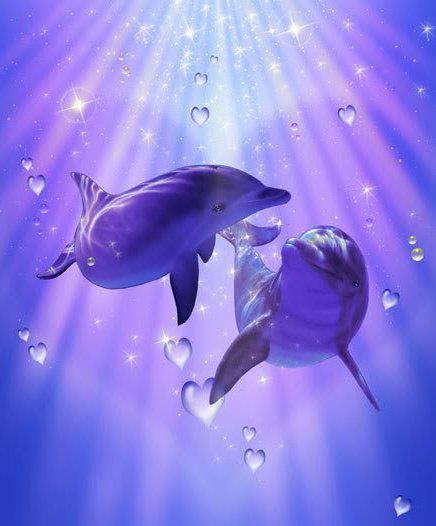
Elu on huvitav. Elame seda. Aidates neid, kes aitavad meid.
Kohtume kl 21…
Armastusega,
Tiina
.jpg)
